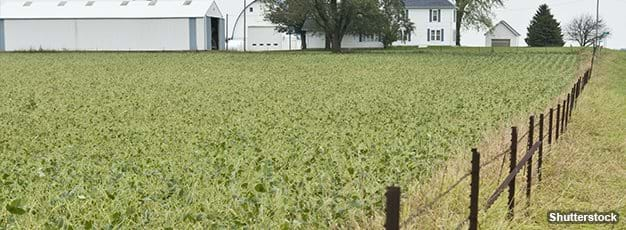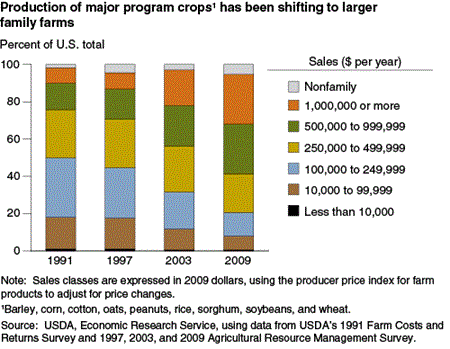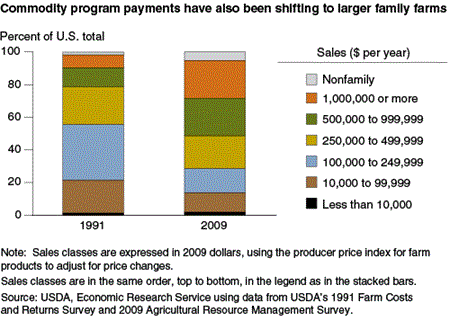Government Commodity Payments Continue To Shift to Larger Farms, Higher Income Households

Highlights:
-
As agricultural production has shifted to farms with larger sales, so, too, has the distribution of commodity-related program payments.
-
Because the average household income of farm operators typically increases with farm sales, farm households with higher incomes are receiving a larger share of commodity program payments than in the past.
-
Barring substantial changes in program design, the shift of commodity program payments toward larger farms and farm households with higher income is likely to continue.
Federal farm commodity programs have been making payments directly to farmers based on either current or historical agricultural production for decades. While commodity program payments to farmers vary considerably from one year to the next, they continue to play an important role in agricultural policy, accounting for $6 billion to $16 billion annually between 1999 and 2009. (Payments from conservation programs are not covered in this article.)
Payments under commodity programs are concentrated among certain types of farms, with under 30 percent of farms receiving commodity program payments in a typical year. Because these payments are based on a farm's current or historical production-current and historical production are highly correlated-ongoing shifts in agricultural production in recent decades to larger farms also shifted the distribution of commodity-related payments over time to larger farms even when the programs did not change. Since the operators of larger farms tend to have higher incomes, commodity-related payments have shifted to higher income households, a trend that will probably continue.
Note that all sales of farm products in this article are expressed in constant 2009 dollars, using the Producer Price Index (PPI) for farm products to adjust for changes in commodity prices. Thus, the shifting of farms from one sales class to another reflects changes in the physical quantity of products sold, not changes in the prices of commodities. Likewise, household income is adjusted for price changes using the Consumer Price Index (CPI).
Complex Array of Programs Provide Payments to Eligible Farmers and Farmland Owners
Federal farm programs include the 'fixed' or direct payments program, the countercyclical payments (CCP) program, and marketing loan benefits programs. In addition, the 2008 Farm Act created the Average Crop Revenue Election (ACRE) program (see 'Switching the Payment Trigger for an Area-Based Revenue Program Could Increase Participation' in this issue), which also provides commodity-related payments, although farmers did not begin receiving ACRE payments until after the period covered in the analysis, 1991 to 2009.
Direct payments and CCPs are based on a farm's historical production, and CCP payments also depend on current market prices. Marketing loan benefits and ACRE payments are tied to current production and market prices. Other, smaller Federal programs target specific farm types, such as the Milk Income Loss Contract program and the tobacco and peanut quota buyout programs, but this article discusses the much larger commodity-related programs.
Not all farms are eligible to receive commodity-related program payments, and among those that do, the payments' role in the farm's finances varies over time and by type of farm. While eligibility criteria are different among programs, most commodity payments go to farmers growing (or who have historically grown) barley, corn, grain sorghum, oats, peanuts, rice, soybeans, upland cotton, wheat, and other oilseeds, collectively referred to as program crops. Furthermore, payments under several of the programs depend on whether the market price for each program crop is above or below specific levels.
Commodity Program Design Affects Payment Levels
By comparing the distribution of commodity payments across farms specializing in different commodities, and during the most recent years in which the market prices of program crops were relatively high (2009) or low (2005), one can illustrate how the design of the commodity programs affects payment levels. Examining commodity payments' share of gross cash farm income (GCFI) indicates how much of a farm's revenue comes from commodity payments.
In 2005, a year when the market price of many program crops was relatively low, about 27 percent of the 2.1 million farms in the 48 contiguous States received commodity-related payments. The number and percentage of farms receiving these payments varied considerably across farm types. For example, about 87 percent of the approximately 291,000 cash grain farms and 95 percent of the roughly 15,000 cotton farms received commodity payments. Cash grains include most of the major program crops.
Lower percentages of other types of farms also receive commodity payments if program crops are (or historically were) among the mix of commodities grown. For example, 6 percent of the farms that specialized in high-value crops (fruit, vegetable, nursery, and greenhouse) and 19 percent of the farms that specialized in raising beef cattle received commodity payments in 2005.
With the notable exception of the direct payments program, the countercyclical design of most commodity-related programs means that in years when commodity prices are low-such as 2005-a higher percentage of farms receive payments, and payments per farm are larger than in years when commodity prices are high. Compared with 2005, a lower percentage of all types of farms reported receiving commodity payments in 2009, a year when the market prices of most program crops were relatively high. Commodity payments as a share of GCFI were also lower in 2009 than in 2005 for all types of farms. Commodity payments' share of GCFI declined especially sharply for cash grain farms, from 14 percent in 2005 to less than 4 percent in 2009.
It is important to note that farm operators do not receive all the benefits of commodity payments. A significant portion of the benefits of payments is captured by nonoperator landlords. Although many farmers own land, roughly 55 percent of farmland and 64 percent of cropland is operated by someone other than the owner, and 94 percent of rented farm land is owned by nonfarmers. Crop farmers may own their land, they may rent some or all of it for cash, or they may rent some or all of it for a share of production (share-rent). Landlords who share-rent are eligible for Government payments, while landlords who cash-rent are not. However, when Government payments are expected to increase, landlords can negotiate higher cash rents and thus capture some of the payments. Long-standing research conducted at ERS and elsewhere suggests that higher payments do increase cash rents.
| Item | Cash grains | Other | Cotton | High-value crops | Beef | Dairy | 48-State total |
|---|---|---|---|---|---|---|---|
| Number of farms (numbers) | |||||||
| 2005 | 291,260 | 880,848 | 15,356 | 140,168 | 705,300 | 61,945 | 2,094,876 |
| 2009 | 322,211 | 1,015,887 | 8,150 | 146,126 | 649,396 | 50,084 | 2,191,853 |
| Farms receiving payments (percent of farms) | |||||||
| 2005 | 87.3 | 13.4 | 95.4 | 6.2 | 18.9 | 65.4 | 27.2 |
| 2009 | 80.7 | 10.3 | 94.0 | 4.5 | 15.0 | 54.9 | 23.0 |
| Average payment per reporting farm (constant 2009 dollars per participating farm) | |||||||
| 2005 | 29,779 | 11,897 | 70,795 | 24,442 | 8,105 | 13,106 | 20,782 |
| 2009 | 12,199 | 7,104 | 47,059 | 15,6272 | 3,988 | 7,738 | 9,883 |
| Share of gross cash farm income, reporting farms (percent for participating farms) | |||||||
| 2005 | 14.2 | 7.5 | 14.2 | 2.9 | 4.4 | 3.2 | 9.3 |
| 2009 | 3.8 | 3.5 | 10.3 | 1.6 | 2.4 | 1.3 | 3.4 |
| 1Farm type defined with value of production. 2This indicates that coefficient of variation (= Standard Error/Estimate x 100) is greater than 25 and less than or equal to 50. Notes: Mean payments are expressed in 2009 dollars, using the Gross Domestic Product chain-type price index to adjust for economy-wide price changes. Gross cash farm income is the sum of the farm's cash and marketing contract revenues from the sale of livestock and crops, Government payments, and other farm-related income, including fees from production contracts. Source: USDA, Economic Research Service using USDA's 2005 and 2009 Agricultural Resource Management Survey. |
|||||||
As Production of Major Program Commodities Has Shifted to Larger Farms…
Since receipt of commodity-related payments depends on current or past production of specific commodities, shifts in production affect the distribution of payments. Production of major program commodities has, in fact, shifted to larger farms over the past 20 years, continuing an earlier trend. Family farms with more than $500,000 (in 2009 dollars) in annual sales accounted for 54 percent of production of the major program crops by 2009, up from only 22 percent in 1991. The production share of small commercial family farms-those with constant dollar sales between $10,000 and $249,999-declined from 49 to 20 percent.
…So, Too, Have Commodity-Related Payments
By 2009, farms with more than $500,000 in constant dollar annual sales received 46 percent of all commodity-related payments, up from 20 percent in 1991. Over the same period, small commercial family farms' share of commodity payments shrank from 54 to 27 percent.
As a Result, Payments Have Shifted to Higher Income Households
Households operating larger farms tend to have higher incomes than the households operating smaller commercial farms. For example, the median operator household income of family farms with sales between $10,000 and $99,999 in 2009 was about $51,000. (The median is the middle of the distribution-half the households have incomes above the median, and half have incomes below the median.) In contrast, in 2009, the median operator household income of farms with sales between $500,000 and $999,999 was about $127,000, and for farms with sales of $1 million or more, median operator household income was $161,000.
Since operators of larger farms tend to have higher household income, the shift of commodity-related payments to larger farms has resulted in a shift of payments to higher income households. For example, in 1991, half of commodity payments went to households with incomes over $54,940 in constant 2009 dollars (50th percentile) and a quarter of commodity payments went to farm households with incomes greater than $115,000 (75th percentile). By 2009, the distribution of payments had shifted upward considerably, with half of commodity payments going to households with incomes over $89,540 and a quarter going to farm households with incomes greater than $209,200.
According to the U.S. Census Bureau's Current Population Survey, the median household income among all U.S. households (in 2009 dollars) was $47,453 in 1991, reasonably close to the household income at the midpoint of the commodity payments distribution. In 2009, the median household income among all U.S. households was $49,777, practically the same as in 1991. But because of the shift in commodity payments, half of the commodity payments went to farm households with incomes that were significantly higher than the incomes of most U.S. households.
| Percentiles of the distribution of commodity-related payments | 1991 operator household income* | 1997 operator household income* | 2003 operator household income* | 2009 operator household income* | Change, 1991 to 2009 (percent) |
|---|---|---|---|---|---|
| 25th percentile | 18,237 | 16,269 | 29,353 | 24,773 | 35.8 |
| 50th percentile | 54,940 | 64,837 | 87,210 | 89,540 | 63.0 |
| 75th percentile | 115,028 | 143,263 | 177,862 | 209,195 | 81.9 |
| 90th percentile | 229,040 | 291,603 | 384,102 | 425,000 | 85.6 |
| Median income, all U.S. households | 47,453 | 49,464 | 50,507 | 49,777 | 4.9 |
| *Constant 2009 dollars. Note: All household income estimates are expressed in 2009 dollars, using the consumer price index. Source: USDA, Economic Research Service using data from USDA's 1991 Farm Costs and Returns Survey and 1997, 2003, and 2009 Agricultural Resource Management Survey. |
|||||
Current Trends Are Likely To Continue
Production of commodities has been shifting to larger farms because larger farms tend to be more profitable. Larger farms will probably continue to be more profitable, and thus commodity production is likely to continue to shift to larger farms. Since commodity program payments are based on current or historical production, payments will continue to shift to larger farms and higher income farm households unless the design of commodity-related programs changes substantially. Congress has created upper limits on the amount of Government program payments that can be made to an individual, as well as income eligibility caps that restrict eligibility to households with income below specified levels. The current payment limits and income eligibility caps affect few recipients and only a small share of total payments. Research conducted at ERS and elsewhere has shown that recent proposals to lower payment limits or income eligibility caps would still affect only a few recipients in the short term. However, over the longer term, if production continues to shift to larger farms, more farm households and a higher percentage of payments may be affected by payment limits and income eligibility caps.
Changing Farm Structure and the Distribution of Farm Payments and Federal Crop Insurance, by Kirk White and Robert A. Hoppe, USDA, Economic Research Service, February 2012



